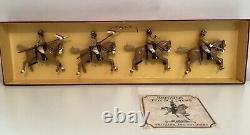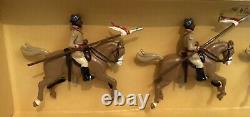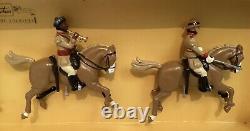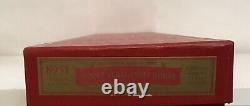
- Britains Toy Soldiers
- Brand
- Britain (17)
- Britain's (26)
- Britains (3132)
- Britains Deetail (428)
- Britains Ltd (19)
- Britains Ltd. (14)
- Charbens (32)
- Crescent (21)
- Deetail (37)
- Herald (19)
- Johillco (26)
- King & Country (39)
- Swoppet (78)
- Taylor & Barrett (17)
- W Britain (48)
- W Britains (50)
- W. Britain (38)
- W.britain (49)
- William Britain (171)
- William Britains (100)
- ... (2058)
- Era
- Material
- Cast Iron (6)
- Die Cast (6)
- Diecast (17)
- Diecast Metal (18)
- Lead (654)
- Lead - Metal (11)
- Metal (223)
- Painted Lead (1348)
- Painted Metal (180)
- Painted Plastic (342)
- Painted Tin (24)
- Painted White Metal (14)
- Paper (11)
- Pewter (26)
- Plastic (91)
- Plastic & Metal (7)
- Polystone Resin (8)
- Resin (8)
- Unpainted Plastic (6)
- White Metal (16)
- ... (3403)
- Nationality
- Scale
- Type
- Accessories (108)
- Artillery (68)
- Castles / Buildings (39)
- Diorama Accessories (9)
- Elephant (9)
- Farm (16)
- Figure (226)
- Horse (13)
- Horses (70)
- Infantry (9)
- Knight (20)
- Lambeth Walk Dancers (9)
- Military (22)
- Military Personnel (1516)
- Scenary (21)
- Soldat (14)
- Soldier (210)
- Tank (19)
- Toy Soldiers (13)
- Vehicles (51)
- ... (3957)
Rare Britains 8951 38th Central India Horse British Army in India + Box









Rare Britains 8951 - 38th Central India Horse - British Army in India + Box. Very Rare New (Never Displayed) - William Britain's Special Collector's Edition'38th Central India Horse' Set 8951 From The British Army in India Series - Forerunner to the Delhi Durbar Range. Vintage - Issued in 1997 (26 Years Old).
Excellent - New Condition - Never Displayed. Check Out My Other William Britain Soldier Sets - Many More The British Army in India, Delhi Durbar, and Other Very Rare Sets From The Early 1930s Onwards. Satisfaction Guaranteed - Take a Look at my Reviews. Sought after by collectors across the world due to their rarity; this is a stunning example of a rare vintage - issued in 1997 (26 years old) - William Britain's Special Collector's Edition four-piece boxed set No. 8951 -'38th Central India Horse' from the British Army in India Series.
The British Army in India Series, was the forerunner to the Delhi Durbar Range, which is one of the reasons they share the same scarlet red boxes, and gold gilded lettering. This six-piece 8951 hand-painted lead set is new - it has never been displayed. All four pieces are in excellent - mint - condition with no chips, dinks, paint flaking or any other visible damage.Comes complete with its original burgundy red box with gilded gold lettering and Britain's Toy Soldiers literature - both are also in excellent condition. This beautifully detailed, crafted and hand painted set would make a great gift or addition to any Britain's display or collection.
Brand/Number: A new never displayed William Britain's Special Collector's Edition four-piece boxed set No. 8951 -'38th Central India Horse' from The British Army in India/Delhi Durbar Collection. Issued: 1997 - vintage (26 years old).
Condition: New - Mint condition. Never displayed Special Collector's Edition'38th Central India Horse' set 8951 is in excellent condition. The colours are bright and clear.
There are no chips, cracks, paint flaking or any other visible damage. Comes complete with its original burgundy red box and attending literature which are also in excellent condition. Please see the enlargeable photos, which form an integral part of this condition report. Take a look at my other listings - which includes many more William Britain's Delhi Durbar, The British Army in India, and other sought after Britain's lead soldier sets from the early 1930s onwards; Churchillian and militaria covering WW1 and WW2; and a diverse range of other collectables. For medium and large parcels over 2 KG I may choose to use a different carrier. Any questions about the GSP?? Brief History of The'38th Central India Horse' Below P&P Section. The regiment was founded as two irregular cavalry regiments in 1857, at the outset of the Indian Rebellion of 1857 by Henry Otway Mayne, and was known initially as Mayne's Horse and the 2nd regiment which was known as Beatson's Horse.They were based at the town of Guna, in the state of Gwalior and Augar in central India. In 1860 Mayne's Horse was renamed the 1st Regiment Central India Horse, and Beatson's Horse was renamed the 2nd Regiment Central India Horse.
In 1860 the officer commanding the Central India Horse was made the British political officer for the small states of Raghugarh, Khaniadhana (after 1888), Paron, Garha, Umri, and Bhadaura, which were made a separate charge from that of the Resident of Gwalior. This arrangement was abolished in 1896, when these states were again placed under the resident, with the officer commanding at Guna continuing to act as ex-officio assistant to the Resident, with very limited powers. Both Regiments would serve together in the Second Afghan War.
During the Kitchener reorganisation of the Indian Army of 1903, the 1st Regiment became the 38th Regiment Central India Horse, and the 2nd regiment became the 39th Regiment Central India Horse. In 1906, the regiments were renamed the 38th and 39th Prince of Wales's Own Central India Horse, and in 1910 the 38th and 39th King George's Own Central India Horse.
During the Great War the 38th King George's Own Central India Horse was part of the 5th (Mhow) Cavalry Brigade in the 2nd Indian Cavalry Division the brigade consisted of the. 2nd Lancers (Gardner's Horse).
38th King George's Own Central India Horse. Later in 1918 the 38th King George's Own Central India Horse joined the 10th Cavalry Brigade, in the 4th Cavalry Division for the Sinai and Palestine Campaign.
The 39th King George's Own Central India Horse remained in India during the war, stationed in Poona. In 1921, the two regiments were amalgamated into the 38th/39th Cavalry, which was renamed the 38th/39th King George's Own Light Cavalry (1922), The Central India Horse (21st King George's Own Horse) (1923), and The Central India Horse (21st King George V's Own Horse) (1937). During the Second World War, the Central India Horse (equipped with Light Tanks and Indian Pattern Carriers) was the divisional reconnaissance regiment for the 4th Indian Division. While attached to the 4th Indian Division they were involved in the Western Desert Campaign, the East African Campaign, the Tunisia Campaign and the Italian Campaign.
It was during the Italian Campaign that two members of the Regiment were posthumously awarded the George Cross: Ditto Ram and St. John Graham Young attached from the Royal Tank Regiment. Notice of the award was published in the London Gazette on 20 July 1945. [2] Young had been leading a night patrol on 23 July 1944, when he and his men found themselves in any enemy minefield. He received the full force of a mine explosion, severely injuring both legs. Despite his wounds, his encouragement enabled the majority of his men to reach safety. One of them, Sowar Ditto Ram, was also posthumously awarded the GC for his actions in the same incident. In 1940 the Central India Horse was posted to Egypt. While awaiting embarkation the train carrying the regiment was kept in a siding for about twenty-four hours. During this delay four members of a radical political organization - the Kirti Lehar were able to persuade two-thirds of the Sikh squadron of the regiment to refuse overseas service. The remainder of the regiment embarked for North Africa and Italy where it served with distinction. On March 20, 1942 Captain Arthur Sandeman of the Central India Horse was on secondment to the Burma Frontier Force - leading a mounted infantry column.Near Toungoo airfield in central Burma the 60-man mounted patrol mistook Japanese troops for Chinese ones and closed with them before realizing their mistake. Most of the patrol (including Sandeman) were killed in what was probably the last cavalry charge by a force under the command of the British crown. [5][6] Also Hon Capt Ram Bhaj was awarded IOM IDSM during the Second World War. When India became a republic in 1950, the regiment was renamed The Central India Horse, which is one of the decorated regiments of the Indian Army. The Central India Horse is now a tank regiment of the Indian Army's XXI Corps (Southern Command).

